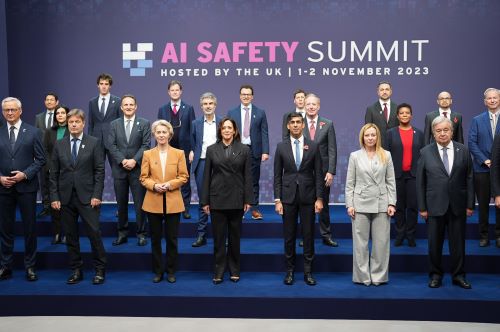

The future of AI is not inevitable. It will be shaped by lawmakers, by communities, by the choices made in committee rooms and town halls.

By Matthew A. McIntosh
Public Historian
Brewminate
The Urgency of Common Ground
Some technologies change the world slowly. Electricity rewired daily life over decades. Automobiles reshaped economies across generations. Others, like artificial intelligence, seem to arrive all at once. Their impact is immediate, uneven, and accelerating.
In the past five years, artificial intelligence has moved from the margins of science fiction into the center of political, economic, and cultural power. It is generating news articles, automating warfare, managing supply chains, and diagnosing disease. It is also disrupting labor markets, reproducing bias, and fueling disinformation. The scale and speed of its rise have outpaced the frameworks meant to keep society safe.
What has not kept pace, and may be most dangerous of all, is the political will to respond coherently. In the United States, AI regulation remains a patchwork of congressional hearings, voluntary industry pledges, and philosophical posturing. Both major parties recognize the stakes, yet bipartisan action remains more a promise than a plan. That inaction may soon carry a price.
A Rapidly Moving Target
Artificial intelligence is not a single thing. It is a suite of technologies that learn from data, often through machine learning models, to perform tasks once thought to require human intelligence. These range from image recognition and language generation to decision-making in areas like finance, law enforcement, and health care.
Because AI systems evolve through training on existing data, they inherit patterns, including the inequities, assumptions, and blind spots embedded in that data. This has led to real-world consequences. Algorithms used in hiring have been shown to disadvantage women and minorities. Predictive policing tools have disproportionately targeted Black neighborhoods. Facial recognition has misidentified people of color at alarming rates.
At the same time, the commercial potential of AI is staggering. Goldman Sachs estimates that AI could boost global GDP by 7 percent over the next decade. Venture capital is pouring into AI startups. Tech giants are racing to integrate language models and automation into every corner of their platforms. There is little incentive for self-restraint.
Without oversight, these systems will continue to evolve according to market logic and engineering priorities. That alone should be reason enough for urgent, clear-eyed regulation. But it is not just about bias, jobs, or competition. AI is increasingly a tool of geopolitical influence and domestic security. That makes governance a national imperative.
What Regulation Could Look Like
Meaningful AI regulation must do more than patch problems after the fact. It must establish enforceable standards for safety, transparency, and accountability. This means clear rules on data sourcing, mandatory testing for bias and robustness, and third-party audits before deployment in high-stakes environments.
It also means defining categories of risk. Not all AI systems require the same scrutiny. A chatbot that helps with calendar appointments is not equivalent to a system deciding who qualifies for parole. The European Union has taken the lead in this space, introducing legislation that categorizes AI applications by their risk level and subjects the most consequential ones to the highest regulatory burdens.
The U.S., by contrast, has yet to pass comprehensive federal legislation. The White House released a blueprint for an AI Bill of Rights in 2022, outlining principles such as safe and effective systems, algorithmic discrimination protections, and human alternatives. But the document remains nonbinding. Its recommendations, however thoughtful, are not enforceable.
Congress has held hearings. Individual lawmakers have proposed bills. The Biden administration convened roundtables with tech executives. Yet these efforts, while important, remain fragmented. No single framework has emerged. And without bipartisan cooperation, none is likely to survive the political cycles ahead.
Why Bipartisanship Matters
In a polarized political climate, expecting bipartisan agreement on anything may seem naïve. But AI presents a rare convergence of concern. Republicans and Democrats may disagree on immigration, education, or energy policy, but both sides express anxiety over what happens when machines begin making decisions once entrusted to human judgment.
Republican lawmakers have voiced concern over censorship, algorithmic bias, and national security. Democrats often emphasize equity, worker protections, and civil rights. These are not incompatible priorities. In fact, they are complementary. Together, they reflect the full spectrum of risks AI presents, from algorithmic discrimination to authoritarian control.
Moreover, regulatory whiplash is not in anyone’s interest. If rules change dramatically with each election cycle, the result will be confusion, litigation, and weakened enforcement. Long-term governance requires legislative stability. That stability only comes when both parties are invested in the outcome.
There is historical precedent. Landmark legislation like the Civil Rights Act, the Americans with Disabilities Act, and even net neutrality rules emerged from moments of unlikely coalition. These laws endured because they were built not on unanimity, but on durable compromise.
Industry Will Not Wait
One of the dangers in legislative delay is that industry will fill the vacuum. Major AI companies have already begun lobbying heavily on Capitol Hill. Some push for light-touch regulation. Others, paradoxically, support stringent rules, knowing that they have the resources to comply, while smaller competitors may not.
Voluntary frameworks like OpenAI’s recent safety commitments or the Frontier Model Forum may create useful norms. But they are not a substitute for law. These initiatives are often as much public relations as public protection. They depend on companies policing themselves, even when incentives tilt in the opposite direction.
And beneath the surface of mainstream platforms are developers and forums building AI tools without oversight or ethical guardrails. Open-source communities may unleash powerful models with little thought to how they could be weaponized. Deepfake generators and synthetic voice tools are already used in harassment and scams. The stakes will only rise as the technology becomes more sophisticated.
A Global Race with No Referee
Internationally, AI is also becoming a race for dominance. China has made clear its intention to lead in artificial intelligence by 2030, investing heavily in military and surveillance applications. The U.S. response has included export controls and defense investments, but little in the way of public regulation.
This leaves open the possibility of a fragmented global AI landscape, where authoritarian regimes deploy AI with few limits and democratic nations scramble to define theirs. In that context, establishing bipartisan guardrails at home is not just a legal question. It is a geopolitical necessity.
Regulation can become a form of soft power. By setting clear, ethical standards, the U.S. could influence global norms and shape the way AI is used worldwide. But it can only do so if its own approach is coherent, credible, and consistent, something that partisanship alone cannot deliver.
Not Just a Tech Issue
Perhaps most important, AI regulation must be seen not as a niche issue for technocrats or Silicon Valley insiders, but as a foundational question of democracy and human dignity.
Who decides what data defines us? Who builds the systems that predict our behavior, approve our mortgages, or recommend our children for gifted programs? Who takes responsibility when machines fail, discriminate, or manipulate?
These are questions that cut across party lines. They speak to fairness, safety, and trust. And they demand answers that are not temporary or tribal, but lasting and shared.
The future of AI is not inevitable. It will be shaped by lawmakers, by communities, by the choices made in committee rooms and town halls. But if we wait for consensus to emerge naturally, it may arrive too late.
What is needed now is something rare, something difficult, and something deeply American: a coalition built not on uniformity, but on common sense, common purpose, and the shared understanding that some technologies are too powerful to leave to chance.
Originally published by Brewminate, 07.31.2025, under the terms of a Creative Commons Attribution-NonCommercial-NoDerivatives 4.0 International license.


